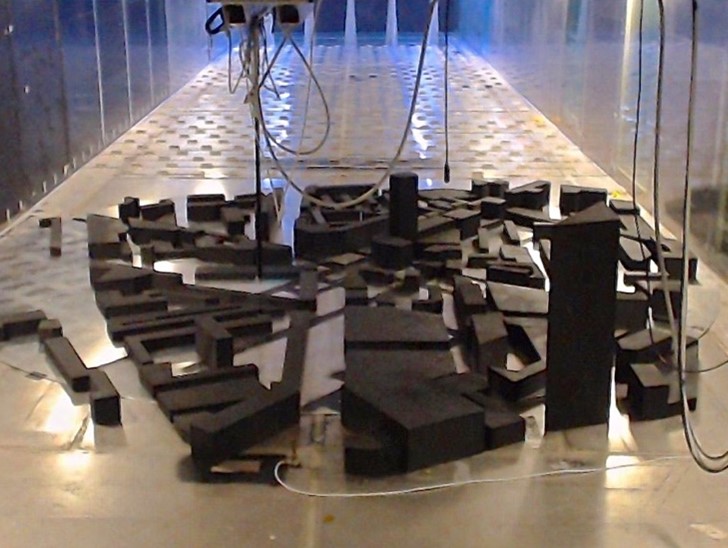Lead Supervisor: Matteo Carpentieri, School of Mechanical Engineering Sciences / EnFlo, University of Surrey
Email: m.carpentieri@surrey.ac.uk
Co-supervisors: Giovanni Iacobello, School of Mechanical Engineering Sciences / EnFlo, University of Surrey; Pietro Salizzoni, Ecole Centrale de Lyon / LMFA
Poor urban air quality and the threat of terrorist attacks by spreading a hazardous substance in cities are a real concern for public safety and health. We need to be able to predict and simulate how gases and particles spread in urban areas. A few existing mathematical models are able to simulate flow velocities and dispersion with reasonable speed and accuracy at the required small scales, however, there are still huge gaps in our knowledge and these models do not work with sufficient accuracy in all conditions. One of the main problem current models have is the way they treat atmospheric stratification.
Stratification is always present in the atmosphere due to variations in temperature and humidity with height. Neutral atmospheric stratification is characterised by an adiabatic profile of potential temperature, meaning that vertical motions of fluid particles are neither amplified nor damped. On the other hand, vertical movements are enhanced in unstable stratification, while stable flows are characterised by attenuated vertical motion. Although stratification plays a very important role in atmospheric flow and dispersion, the vast majority of studies focus only on neutral flows, mainly because they are order of magnitudes simpler to study both experimentally and numerically. The proposed research aims to start bridging this gap using one of the very few facilities in Europe and in the world that is capable of establishing suitable non-neutral boundary layer flows.

1:200 scale model of a London neighbourhood inside the EnFlo wind tunnel at the University of Surrey
Non-neutral stratification (either stable or unstable) in atmospheric flows is very common and can be present for over 70% of the time in a typical year [1]. The distribution of mean velocity and turbulence quantities with height are very different in these categories of wind flow, depending upon the degree to which the flow is stable or unstable. Turbulence can be either suppressed or enhanced, depending on the stability conditions. In urban areas there is an added layer of complexity, due to the wide range of different scales that interact with each other. The increased roughness and other phenomena such as the “urban heat island” lead to increased mechanical and convective turbulence. At smaller scales, such as those of the neighbourhood and street, thermal stratification is generally neglected by mathematical models, owing to the fact that other local features (geometry, turbulence, traffic-induced turbulence) are generally argued to be more important. This assumption has recently been proven wrong by the research carried out at EnFlo [2] [3] [4]. In wind tunnel urban models, for example, gas concentrations were found to be up to twice as large in stable conditions when compared to neutral [4].
The work cited above, beside establishing the importance of atmospheric non-neutral stratification on flow and dispersion in urban areas at the local scale, has also enabled, for the first time, the development of suitable experimental techniques to simulate non-neutral urban flows in a wind tunnel environment. With this new capability we can now tackle the problem of understanding the physical processes of small-scale flow and dispersion in urban areas using the EnFlo meteorological wind tunnel at the University of Surrey.
In particular, the proposed project will:
- Develop and optimise experimental techniques to simulate stronger non-neutral conditions (both stable and convective) in the lab, as previous research only focussed on weak stratification.
- Study and benchmark (using the wind tunnel techniques developed previously and in 1) significant test cases, including:
- Simple plume in a rough non-neutral boundary layer
- Street canyons and intersections, including local thermal effect
- Isolated buildings, including local thermal effects
- Develop mathematical parametrisations and analytical approaches to enhance the capabilities of empirical air quality/micro-climate models. Work on mathematical modelling and other fundamentals in the physics of the problem will be supported by the project partners at the LMFA, Ecole Centrale de Lyon. They have an extensive track record on this topic.
Training Opportunities
Specialised MSc modules on various aspects of atmospheric fluid mechanics are available at both the Universities of Surrey and Reading. The student will also be encouraged to take part in the Summer School “Introduction to Atmospheric Science” offered by the NCAS in Leeds (UK) and “Introduction to Measurement Techniques” Lecture Series at VKI (Belgium). Specialist training will be provided for the required experimental skills.
Student Profile
This project will best suit a student with a first degree in a relevant engineering field (aeronautics, environmental, civil, mechanical) or physical/environmental science (physics, meteorology). We are seeking candidates preferably with a first-class degree or a good 2:1, and proficient with the English language. Good team working and communications skills are also essential. Previous experience, or a keen interest in experimental work would be beneficial. Some level of computer-coding skills might be advantageous, but it is not necessary.
References
1] Wood, C.R., Lacser, A., Barlow, J.F., Padhra, A., Belcher, S.E., Nemitz, E., Helfter, C., Famulari, D. & Grimmond, C.S.B. (2010). “Turbulent flow at 190m height above London during 2006-2008: a climatology and the applicability of similarity theory.” Boundary-Layer Meteorology 137 (1), 77–96.
[2] Marucci, D., Carpentieri, M., Hayden, P. (2018). “On the simulation of thick non-neutral boundary layers for urban studies in a wind tunnel.” International Journal of Heat and Fluid Flow 72, 37–51.
[3] Marucci, D., Carpentieri, M. (2019). “Effect of local and upwind stratification on flow and dispersion inside and above a bi-dimensional street canyon.” Building and Environment 156, 74-88.
[4] Marucci, D., Carpentieri, M. (2019). “Dispersion in an array of buildings in stable and convective atmospheric conditions.” Atmospheric Environment (in press), 117100.

